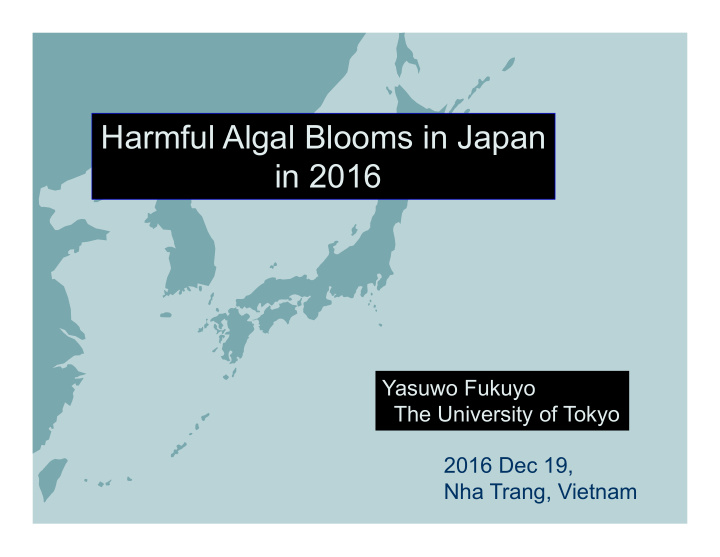



Harmful Algal Blooms in Japan in 2016 Yasuwo Fukuyo The University of Tokyo 2016 Dec 19, Nha Trang, Vietnam
HAB condition and recent trend in these few yrs 1. Red tide case numbers is in the same level as previous several years 2015, 236 cases with 44 harmful ones 2016 Jan-Oct, ca. 180 cases with 23 harmful ones 2. Economic loss by red tides 2013: 2.7M USD, 2014: 2.6M USD 2015: 6.2M USD, 2016 Jan-Oct: 4.6M USD 3. Main harmful species are Karenia mikimotoi, Chattonella antiqua, Cochlodinium polykrikoides and Heterosigma akashiwo. 4. Often seaweed, Pyropia sp. growing on drifting-nets had damage of de-coloration. Dark reddish black color turned to pale green, because of lack of enough nutrients, especially DIP.
east – west: 450 km, north – south:15-55 km area: 23,203 km 2 , average depth: 38.0 m shoreline: 6,868 km, 700 islands Numbers above bars show total case number of red tides, and those inside Red tide case number bar show those with economic losses. 2010 2015 1973 1990 1995 2000 2005 1975 1980 1985 (Year)
HAB condition and recent trend in these few yrs 5. Closure of harvesting shellfish by contamination of PSP toxins. 2013: 10 plankton-feeding species in 22 cases 2014: 12 species in 33 cases 2015: 10 species in 33 cases 2016 Jan-Nov: 08 species in 22 cases Causative plankton are Alexandrium tamarense, A. catenella, A. tamaiyavanichii and Gymnodinium catenatum. 5. DSP toxins are also recorded. 2013: 03 species in 33 cases 2014: 04 species in 14 cases 2015: 03 species in 06 cases 2016 Jan-Nov: 03 species in 06 cases Causative plankton are Dinophysis fortii, D. acuminata, and D. norvegica. 6. Amount of economic loss has not been calculated so far.
Change of harvesting closure case numbers by PSP and DSP toxins in the last 10 years Case number PSP DSP 07 08 09 10 11 12 13 14 15 16 Year
Change of PSP affected area Serious economic loss, but no poisoning case
Major research topics (mainly for red tide) 1. Biology morphology and molecular characters to develop DNA markers to make an organism detection kit 2. Ecophysiology adaptation mechanisms to new environment with reduced nutrients and temperature change 3. Dynamics blooming mechanisms fish mortality mechanisms 4. Measures (ca. 1.5 M USD by Fisheries Agency) prevention of mass mortality using specific virus prevention of fisheries damage by information exchange (temperature and red tide distribution information) bloom modeling for early warning nutrient level monitoring to prevent de-coloration of seaweed provision of safe seafood monitored by reliable systems
De-coloration of Pyropia sp. growing on drifting-nets Dark reddish black color turned to pale green, because of lack of enough nutrients, especially DIP. Frequent occurrence of de-coloration Production/ Price Price per sheet (cent) Production (M sheet) Normal (left) and de-colored Porphyra on net Production (10M USD) Normal (left) and de-colored Porphyra thali Main competitors with Nori Porphyra on nutrient uptake. Above: Coscinodiscus weilesii Left: Eucampia zodiacus Normal (left) and de-colored product
Recommend
More recommend